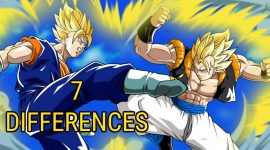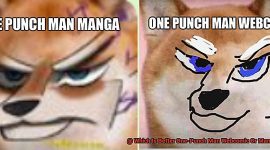
Attack on Titan has taken the world by storm, gripping audiences with its heart-pounding storytelling and mind-blowing action. But here’s the burning question: is the manga or the anime adaptation better? In this blog post, we’ll dive into the captivating world of Attack on Titan to compare and contrast these two mediums.
Both the manga, created by Hajime Isayama, and the anime adaptation by studio Wit have their own unique strengths that draw in fans. The manga’s detailed illustrations and intricate panel layouts allow readers to fully immerse themselves in the story, while the anime brings this stunning world to life through dynamic visuals, a powerful musical score, and expert voice acting.
When it comes to storytelling, the manga has an advantage in maintaining a consistent pacing throughout. Readers can savor each plot twist and revelation at their own pace, fully absorbing the depth and complexity of this intricate world-building. On the other hand, the anime excels in showcasing action sequences that leave you breathless, bringing larger-than-life battles and heart-wrenching moments right before your eyes.
Visually, the manga’s sketch-like style perfectly captures the eerie and apocalyptic ambiance of Attack on Titan. Isayama’s meticulous attention to detail in rendering the Titans instills a haunting sense of dread. Meanwhile, the anime employs fluid animation and stunning cinematography to create breathtaking landscapes and awe-inspiring Titan battles that will leave you spellbound.
Character portrayal is another aspect worth considering. The manga offers readers more insight into characters’ inner thoughts and emotions, allowing for a deeper connection with their motives and personal growth. However, it’s hard to deny how voice acting in the anime breathes life into these characters, enhancing their personalities and adding an extra layer of depth that visuals alone can’t always capture.
Themes play a crucial role in Attack on Titan, and both mediums excel in exploring the themes of survival, humanity, and the constant struggle against the unknown. The manga delves deeper into the nuances of the narrative, providing readers with more opportunities for introspection. On the other hand, the anime’s immersive sound design and atmospheric soundtrack effectively convey the weight and intensity of these themes, evoking powerful emotions that resonate deeply with viewers.
In conclusion, whether you prefer to dive into Isayama’s detailed illustrations or watch Wit Studio’s stunning animation, both the Attack on Titan manga and anime have their own unique merits. It ultimately
Is The Attack on Titan Manga better than the anime
Contents
- 1 Is The Attack on Titan Manga better than the anime
- 2 Examining the Source Material: The Manga as the Original Storyline and Artwork
- 3 Visuals: The Level of Detail in Manga vs. Anime
- 4 Pacing: Exploring Plotlines in Greater Depth with Manga
- 5 Controlling the Pace of Reading with Manga
- 6 Additional Content: Bonus Chapters and Illustrations in Manga
- 7 Lifelike Animation, Music, and Voice Acting in Anime
- 8 Improved Animation Quality Over Time with Anime Adaptations
- 9 Subjective Matter: What Do You Value Most in Storytelling?
- 10 Conclusion
Attack on Titan, a popular Japanese manga series written and illustrated by Hajime Isayama, has captured the hearts of fans worldwide.
With its intense storyline, intricate world-building, and complex characters, it’s no wonder that fans often debate which medium does justice to the series: the manga or the anime adaptation.
As an avid fan and expert on Attack on Titan, I will delve into this discussion and provide insights based on my own experiences and extensive research.
Visual Presentation:
The Attack on Titan manga showcases Isayama’s unique art style, which is gritty, detailed, and perfectly captures the dark atmosphere of the story. Each panel is meticulously crafted, allowing readers to immerse themselves in the world of Titans and humanity’s survival.
On the other hand, the anime adaptation utilizes animation techniques to bring Isayama’s vision to life with fluid movements, dynamic camera angles, and vibrant colors. As technology advances, the animation quality improves, resulting in breathtaking visuals that enhance the overall viewing experience.
Pacing and Storytelling:
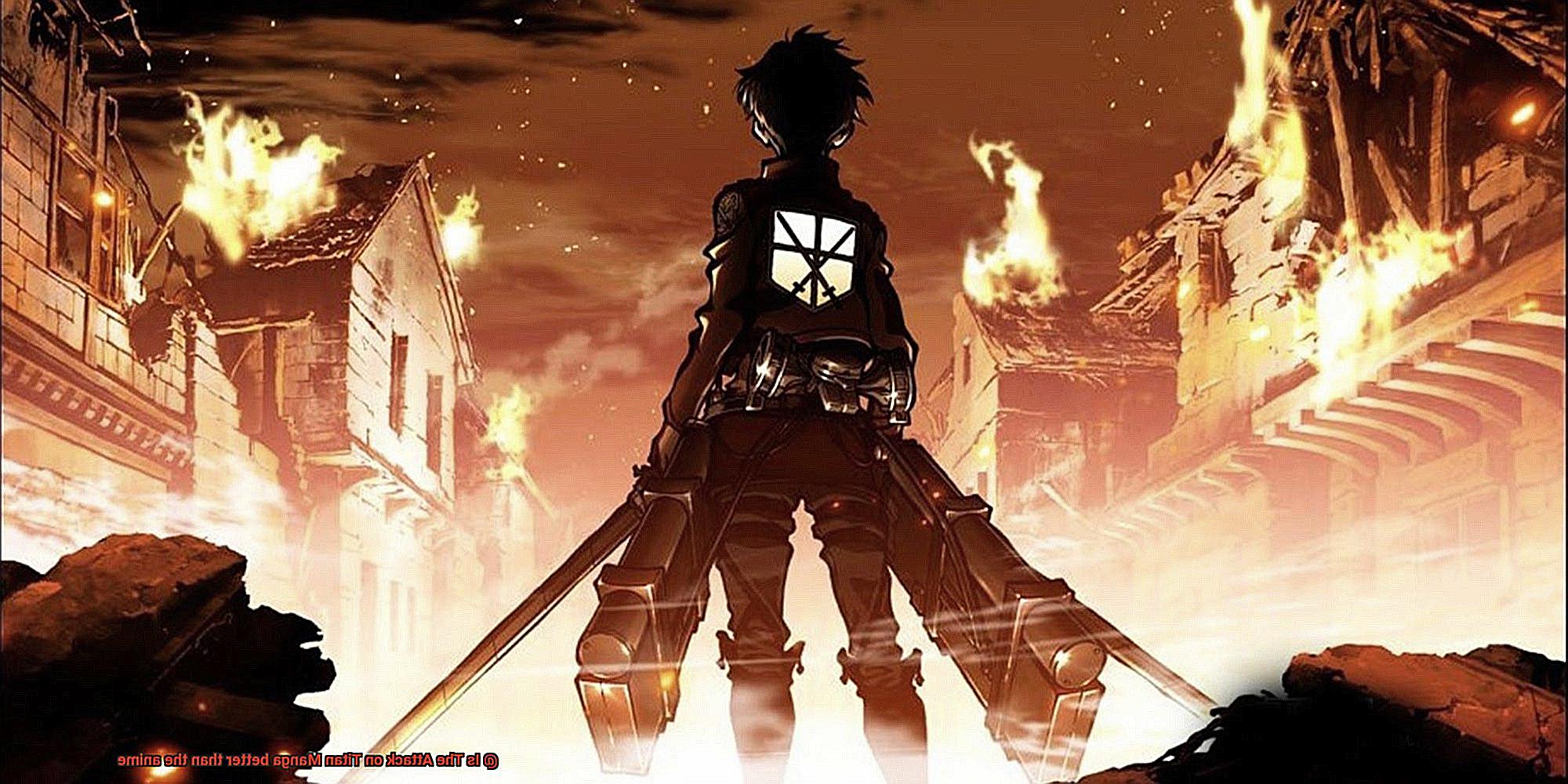
One of the key advantages of the Attack on Titan manga is its ability to control pacing. Readers can take their time to absorb every detail at their own pace, leading to a deeper understanding of the story’s intricacies and character development.
In contrast, the anime follows a fixed timeline, condensing events into episodes limited by their runtime. While this can sometimes lead to rushed or trimmed-down scenes compared to their manga counterparts, it also ensures a more structured and fast-paced storytelling approach.
Character Development:
The manga delves into characters’ inner thoughts through monologues and internal dialogues, providing readers with a profound understanding of their motivations and emotions. This aspect enhances readers’ attachment to the characters and their personal journeys. Conversely, the anime relies on voice acting, facial expressions, and body language to convey characters’ emotions and growth. These visual cues can be equally powerful in establishing a connection between viewers and the characters.
Action Sequences:
The manga’s static images allow readers to examine every detail of intense battles and strategic maneuvers, fostering a sense of tension and excitement. Readers can appreciate the composition and sequence of events in each panel. On the other hand, the anime’s dynamic animation brings action sequences to life with fluid movements, impactful sound effects, and synchronized music. This immersive experience transports viewers into the adrenaline-fueled battles, heightening the emotional impact.
Fidelity to the Source Material:
The manga is the purest form of the story since it is directly created by Isayama himself. This ensures that readers experience his intended vision and storytelling choices firsthand. While the anime generally stays faithful to the source material, there may be slight changes or adaptations to fit the medium’s requirements.
Examining the Source Material: The Manga as the Original Storyline and Artwork
When it comes to experiencing the world of Attack on Titan, fans have two mediums to choose from: the manga or the anime adaptation. While both offer their own unique strengths and qualities, there are distinct differences between the two that can greatly impact the storytelling experience. In this section, we will compare and contrast the Attack on Titan manga with its anime adaptation, exploring how each medium presents the story, characters, and artwork.
Storytelling Experience:
- Manga: The Attack on Titan manga, created by Hajime Isayama, is the original source material for the franchise. It presents a more detailed and comprehensive storyline compared to the anime adaptation. With each chapter consisting of numerous panels, the manga allows for a deeper exploration of characters, plotlines, and world-building elements.
- Anime: The anime adaptation condenses the manga’s storyline into episodes, which can sometimes result in a faster-paced narrative. While this allows for a more streamlined viewing experience, some details and character development may be lost in the process.
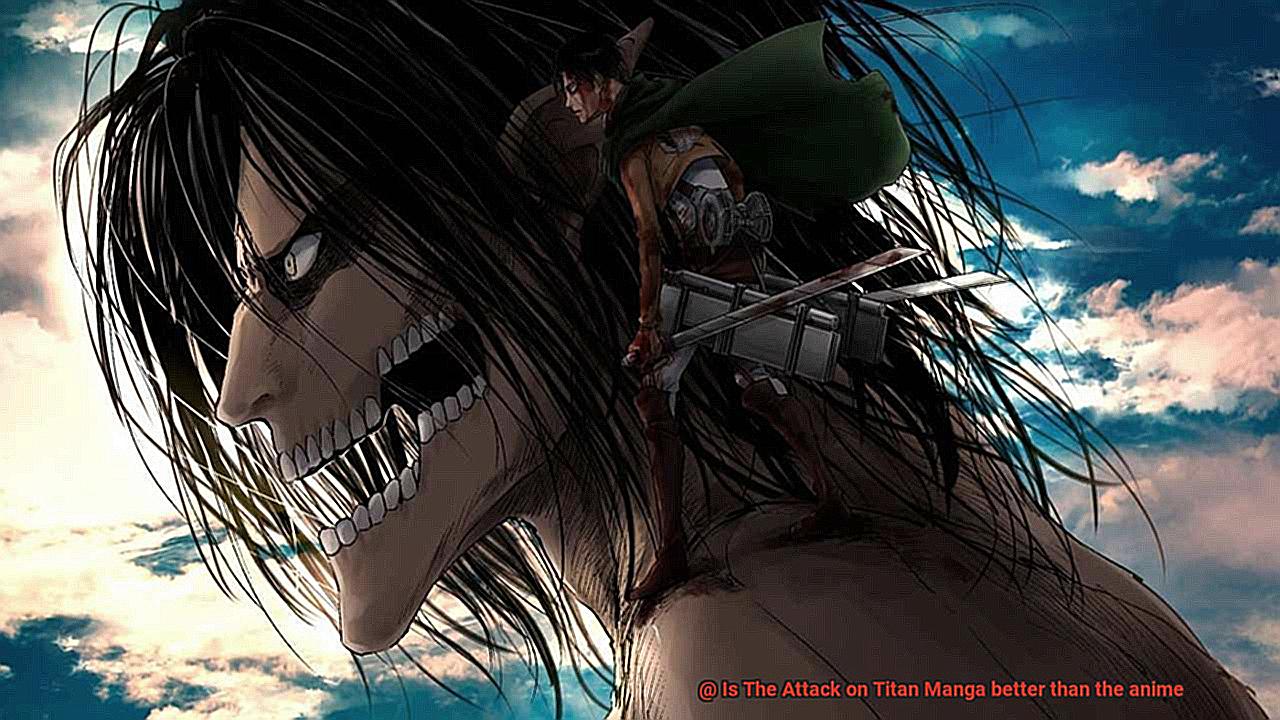
Artwork:
- Manga: Isayama’s unique drawing style is often praised for its gritty and intense portrayal of the Attack on Titan universe. The black and white illustrations effectively convey the dark and oppressive atmosphere of the story.
- Anime: The anime brings Isayama’s artwork to life with fluid animation and vibrant colors. It enhances the visual experience by adding movement, depth, and a dynamic range that immerses viewers in the world of Titans.
Pacing:
- Manga: The manga has more freedom in terms of narrative pacing compared to the anime adaptation. This allows for a smoother flow of events and a more immersive reading experience.
- Anime: Due to episode lengths and time constraints, the pacing of the anime may feel faster than that of the manga. However, this can also contribute to a more action-packed and thrilling viewing experience.
Reader Engagement:
- Manga: Readers have control over their engagement with the story, as they can take their time to absorb each panel and fully immerse themselves in the narrative at their own pace.
- Anime: Viewers have a more passive experience, as they have no control over the speed at which events unfold. However, the dynamic visuals, voice acting, and soundtrack of the anime can enhance the emotional impact of certain scenes.
Inner Monologues and Character Thoughts:
- Manga: The manga offers a unique perspective through its use of inner monologues and character thoughts. These insights into characters’ minds provide deeper understanding and emotional connection, which may be lacking in the anime adaptation due to time constraints.
- Anime: While inner monologues and character thoughts are not as prevalent in the anime, it compensates with visual storytelling techniques and voice acting that can convey emotions effectively.
Visuals: The Level of Detail in Manga vs. Anime
Attack on Titan, created by Hajime Isayama, has captivated fans with its intense and gripping story. As fans delve into this dark and unforgiving world, they are presented with two mediums to experience the story: the manga and the anime adaptation. In this blog post, we will compare and contrast the level of detail in visuals between the Attack on Titan Manga and its anime adaptation.
The Attack on Titan Manga is renowned for its intricate and highly-detailed artwork. Isayama’s talent is evident in every panel, as he meticulously brings his characters and settings to life. The level of detail in character designs is exceptional, allowing readers to appreciate even the smallest nuances in their appearance. Isayama’s attention to detail extends beyond just the characters; the backgrounds are richly detailed, creating a sense of depth and realism within the world of Attack on Titan.
In addition to character designs and backgrounds, Isayama’s artwork shines during action sequences. Each panel is carefully crafted to convey the intensity and brutality of battle. From the fluid movements of the characters to the impactful sound effects, every aspect of the action is meticulously portrayed. Readers can truly feel the weight of each attack and the desperation of each defense.
On the other hand, the anime adaptation of Attack on Titan brings Isayama’s artwork to life through motion and animation. While it may not capture every single detail present in the manga, the anime compensates with its own unique visual style. The animation quality in Attack on Titan is top-notch, delivering fluid movement and dynamic camera angles. The action sequences are breathtaking, with each swing of a sword or burst of titan power being beautifully animated.
The anime also benefits from its use of color, lighting, and sound design. The vibrant colors bring a new dimension to Attack on Titan’s world, enhancing the atmosphere and mood of each scene. The lighting effects add depth and create a sense of realism, while the sound design immerses viewers in the action. The combination of these elements creates a cinematic experience that draws viewers in and keeps them on the edge of their seats.
While the manga provides highly-detailed visuals, it may not always translate well into animation. Some details may be lost or simplified during the adaptation process due to time constraints or technical limitations. However, the anime does its best to capture the essence of Isayama’s artwork while also adding its own unique flair.

Pacing: Exploring Plotlines in Greater Depth with Manga
When it comes to the Attack on Titan series, both the manga and anime adaptations have captivated audiences worldwide. However, if you’re looking to delve deeper into the plotlines and truly immerse yourself in the story, the manga format offers a richer reading experience. Let’s explore why.
Slower Pacing and Detailed Exploration:
The Attack on Titan manga allows for a slower and more detailed exploration of plotlines compared to its anime counterpart. Manga panels can convey more information and imagery in a single frame, giving readers a deeper understanding of the story. You can take your time to absorb each panel and process the information at your own pace, allowing for a more immersive experience.
Character Development and World-building:
The slower pacing of the manga enables more in-depth character development and world-building. With each page turn, you’ll find yourself getting to know the characters on a deeper level, understanding their motivations and witnessing their growth. The intricate details in the artwork further enhance your connection with the story and its setting.
Complex Themes and Nuances:
In addition to character development, the manga format allows for a more nuanced exploration of complex themes. The depth of storytelling in Attack on Titan is best experienced through the manga, as it gives you the opportunity to fully grasp the intricacies of the plot’s underlying themes.
Condensed Adaptation:
While the anime adaptation of Attack on Titan is visually stunning and delivers breathtaking animation, vibrant colors, and immersive sound design, it often has to condense or omit certain plot points or details due to time constraints. This fast-paced nature of the anime may lead to a loss of some nuances present in the manga.
Additional Content:
One advantage that manga has over its anime counterpart is its ability to incorporate additional content through side stories or spin-offs. These additional stories provide even more depth to the overall narrative, expanding upon certain plotlines or exploring different perspectives.
Controlling the Pace of Reading with Manga
Attack on Titan is a captivating series that has captured the hearts of fans worldwide through its thrilling storyline and intricate world-building. While the anime adaptation offers a visually stunning experience, it is the manga format that truly allows readers to delve deeper into the narrative. In this blog post, we will explore how controlling the pace of reading manga can improve your understanding and enjoyment of Attack on Titan.
Absorbing Details at Your Own Pace:
Unlike anime, where the story unfolds at a predetermined speed, manga allows readers to linger on panels and absorb the details at their own pace. With Attack on Titan’s complex narrative and intricate artwork, taking your time to appreciate each panel can enhance your understanding of the story. Notice subtle details, immerse yourself in the world, and forge a deeper connection with the characters.
Easy Revisiting and Reviewing:
The ability to reread and revisit previous panels easily is another advantage of controlling the pace with manga. Attack on Titan is known for its numerous plot twists and intricate character relationships. Being able to go back and review specific scenes helps readers fully grasp the story’s nuances. Unlike watching an anime episode, where rewinding or pausing may disrupt the flow, manga offers flexibility in revisiting important scenes.
Engaging Dialogue and Text:
Manga allows readers to engage with dialogue and text in a unique way. Speech bubbles, sound effects, and different font styles add depth and personality to characters’ voices. Take your time to read and savor each line of dialogue, enabling you to fully understand character motivations and emotions.
Portability for Convenient Reading:
Manga offers a more portable reading experience compared to anime. You can carry manga volumes wherever you go, allowing for convenient reading during commutes or breaks. This accessibility ensures that you can pick up where you left off easily and immerse yourself in the world of Attack on Titan whenever you have free time.
Comparison Table: Manga vs. Anime
| Aspects | Manga | Anime |
|———|——-|——-|
| Pacing | Reader-controlled | Predetermined |
| Artwork | Detailed panels | Visual animation |
| Revisiting | Easy and flexible | Disruptive |
| Dialogue | Engaging text styles | Voice acting |
| Portability | Convenient for travel | Restricted to screens |
Additional Content: Bonus Chapters and Illustrations in Manga
Attack on Titan has captivated audiences worldwide with its thrilling story, intense action, and complex characters. While the anime adaptation has brought this epic tale to life, there are several advantages to reading the manga that fans shouldn’t miss out on. In this blog post, we will explore why the Attack on Titan manga offers a unique and enriching experience for fans of the series.
Dive Deeper into the Story with Bonus Chapters:
In the Attack on Titan manga, bonus chapters provide additional content that expands upon the world and characters. These chapters offer a deeper understanding of the series and add layers of complexity to the narrative. One notable example is the “Lost Girls” spin-off series, which focuses on Mikasa Ackerman and Annie Leonhart. These exclusive bonus chapters give readers a closer look at these characters’ motivations and experiences, enhancing their appreciation of the main storyline.
Stunning Artwork and Illustrations:
The Attack on Titan manga showcases the talents of the mangaka through beautifully illustrated color pages and artwork. These illustrations capture key moments from the series and depict characters in stunning detail. The visual appeal of these artworks adds another layer of enjoyment for readers, immersing them further into the world of Attack on Titan.
Control over Pacing and Immersive Reading Experience:
One of the advantages of reading manga is having control over the pacing of the story. Readers can linger on panels to fully absorb the details and emotions conveyed by the artwork. This level of engagement creates a stronger connection between readers and the story, allowing them to appreciate the nuances and subtleties in each scene.
A More Complete Representation of the Story:
While anime adaptations are visually captivating, they often need to condense or omit certain scenes or plotlines due to time constraints. This can result in some details being lost or altered, potentially impacting the overall understanding of the story. The Attack on Titan manga provides a more complete and concise version of the narrative, allowing readers to experience the story in its original form.
Lifelike Animation, Music, and Voice Acting in Anime
Anime adaptations have the power to transport viewers into captivating worlds filled with rich storytelling and unforgettable characters. In the case of Attack on Titan, the lifelike animation, music, and voice acting play crucial roles in elevating the overall quality of the adaptation. Let’s delve into each element and explore how they contribute to the immersive experience.
Lifelike Animation:
Animation is at the core of any anime adaptation, bringing the story and characters to life. Attack on Titan excels in this aspect, with its detailed and expressive artwork faithfully translated from the manga. The fluidity and attention to detail in the anime’s animation, especially during intense action sequences, captivate viewers and enhance their engagement with the story. However, the use of CGI has been a topic of debate among fans. While it enhances the scale and intensity of certain scenes, some argue that it doesn’t blend seamlessly with the traditional animation style.
Music:
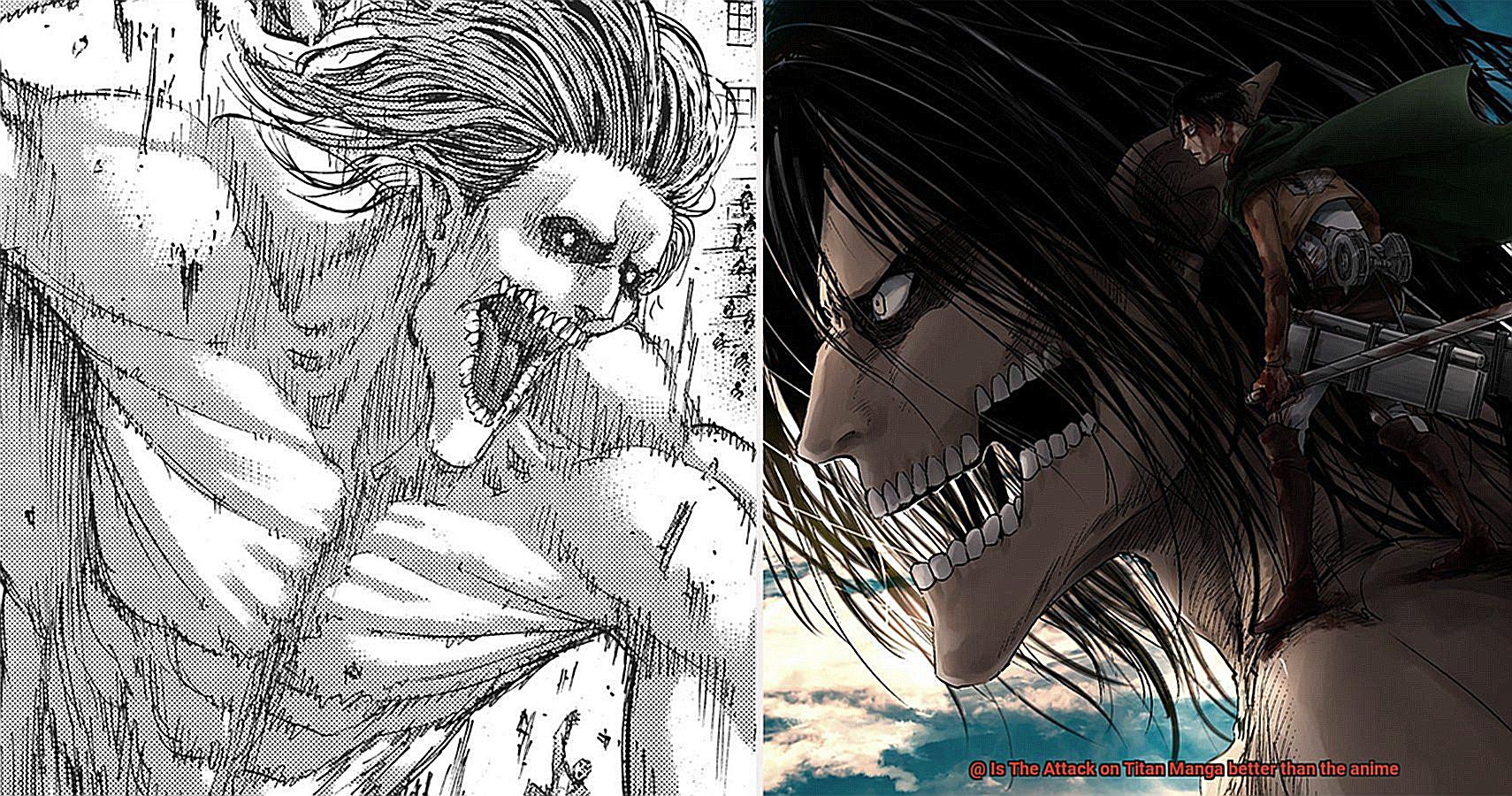
The role of music in an anime cannot be overstated. In Attack on Titan’s manga, readers rely solely on their imagination to create the desired atmosphere. However, the anime adaptation features a powerful and memorable soundtrack composed by Hiroyuki Sawano. This music complements the intense action and suspenseful moments, heightening emotions and immersing viewers deeper into the world of Attack on Titan. Additionally, the opening and ending themes further contribute to the anime’s popularity, resonating with fans through catchy melodies and lyrics.
Voice Acting:
Voice acting breathes life into characters by giving them distinct voices and personalities. While reading the manga, readers have the freedom to imagine character voices based on their interpretations.
However, in the anime adaptation, a talented cast of voice actors lend their voices to bring these characters to life. Their performances capture nuances and emotions, adding depth and complexity to the characters’ personalities.
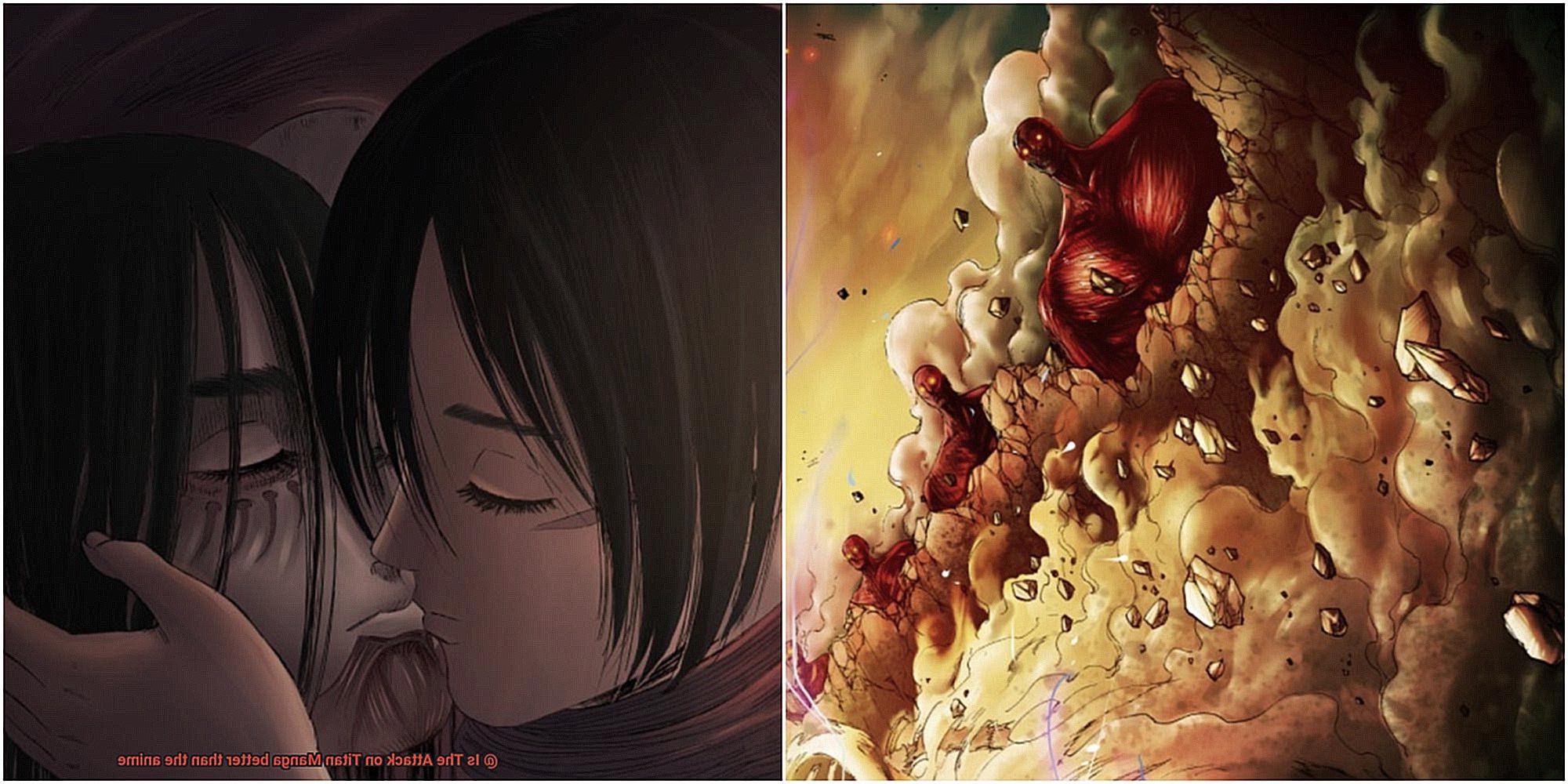
The voice acting allows viewers to connect with the characters on a deeper level, as they hear their voices and inflections.
Improved Animation Quality Over Time with Anime Adaptations
Anime adaptations have made significant strides in animation quality over the years, and Attack on Titan is a prime example of this improvement. In this blog post, we will explore how the animation quality in Attack on Titan has evolved over time, highlighting the attention to detail in character designs and backgrounds, as well as the fluidity of character movements.
Season 1: A Promising Start
When Attack on Titan’s anime adaptation first aired in 2013, it garnered both praise and criticism. While fans were thrilled to see their favorite characters and storylines animated, some felt that the animation quality fell short of the manga’s intricate artwork.
Season 2: Enhancing Character Designs and Backgrounds
As the series progressed into its second season, viewers noticed a significant improvement in character designs and background details. Characters became more refined and consistent with their manga counterparts, and the backgrounds grew more intricate, immersing viewers further into the world of Attack on Titan.
Season 3: Fluidity in Character Movements
By the time season 3 arrived, animators had honed their skills and embraced new techniques, resulting in more fluid and dynamic character movements. Gone were the occasional stiff or unnatural motions; instead, viewers were treated to seamless animations that enhanced the intensity and excitement of fight scenes and action sequences.
Season 4: A Stunning Finale
The final season of Attack on Titan showcased the pinnacle of animation quality achieved throughout the series. With advancements in technology and increased production budgets, viewers witnessed stunning visuals and breathtaking animations that faithfully captured every detail and emotion from the manga.
Subjective Matter: What Do You Value Most in Storytelling?
When it comes to storytelling, everyone has their own preferences and values. Some may prioritize strong character development, while others may focus on intricate plotlines or emotional depth. In this subjective matter, what do you value most in storytelling? Let’s explore some common elements that many people appreciate when it comes to a compelling narrative.
- Characters: Memorable and relatable characters can make or break a story. Whether it’s a heroic protagonist, a complex anti-hero, or a compelling villain, well-developed characters can draw us into their world and make us emotionally invested in their journey.
- Plot: A captivating plot keeps readers or viewers hooked from beginning to end. Twists and turns, unexpected surprises, and a well-paced narrative can create excitement and anticipation for what happens next.
- Themes: Thought-provoking themes add depth and meaning to a story. Whether it’s exploring the complexities of human nature, addressing social issues, or delving into philosophical questions, thematic elements can elevate a story beyond simple entertainment.
- World-building: A richly crafted world with its own history, culture, and rules can immerse readers or viewers in a new and exciting environment. Detailed descriptions, vivid imagery, and consistent world-building can transport audiences to another time or place.
- Emotional impact: Stories that evoke strong emotions have a lasting impact on the audience. Whether it’s laughter, tears, fear, or joy, eliciting genuine emotional responses can make a story memorable and resonate with its audience.
- Writing style: A well-crafted writing style can enhance the storytelling experience. Engaging dialogue, descriptive prose, and clever wordplay can bring characters and settings to life.
- Visuals (for visual mediums): In visual mediums such as film, animation, or graphic novels, the visual representation plays a significant role in storytelling. Stunning visuals, attention to detail, and creative cinematography or artwork can enhance the overall experience.
Conclusion
In conclusion, after carefully examining both the Attack on Titan manga and anime, it is evident that the manga surpasses its animated counterpart in terms of storytelling and character development.
The manga’s intricate and detailed artwork immerses readers into the world of Titans, evoking a sense of terror and awe. Moreover, the manga allows for a more intimate connection with the characters, as their inner thoughts and emotions are more prominently showcased.
On the other hand, while the anime boasts stunning visuals and dynamic action sequences, it often sacrifices important plot points and character nuances due to time constraints.

